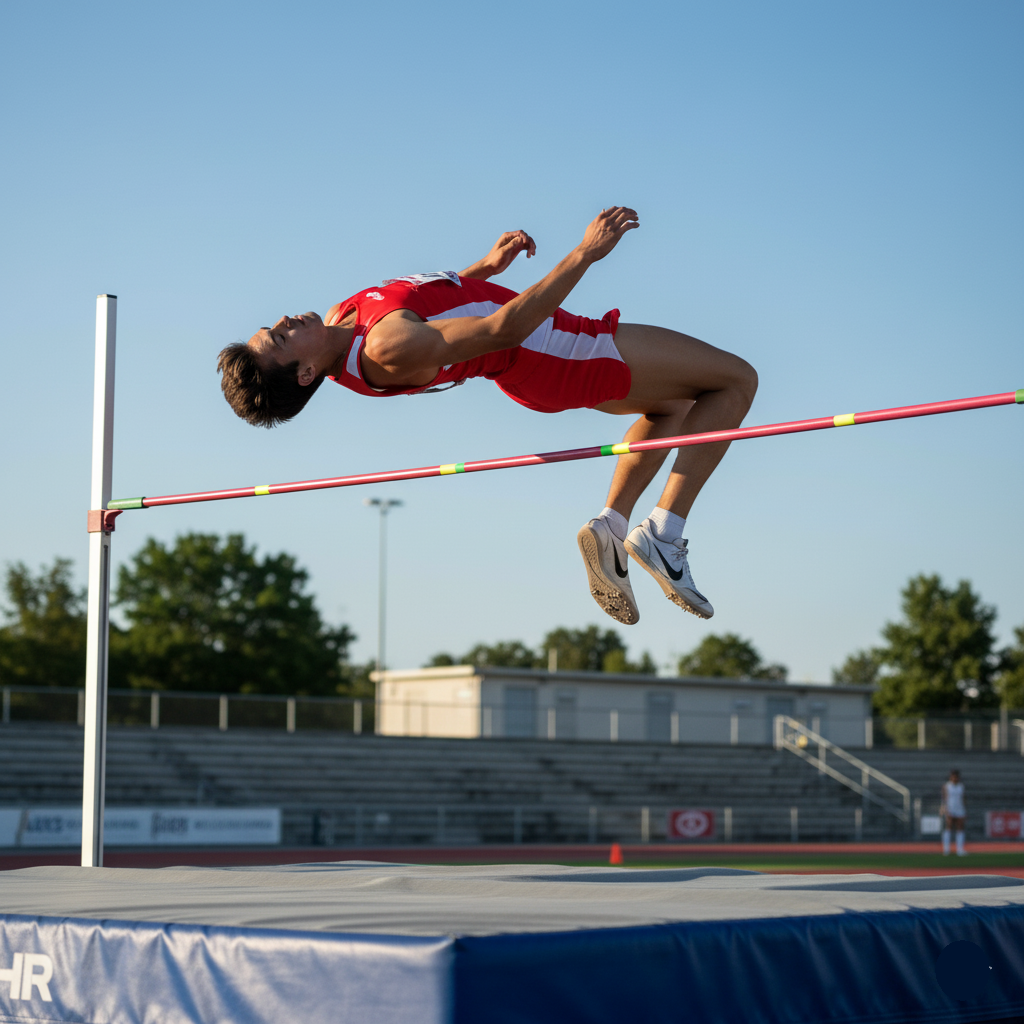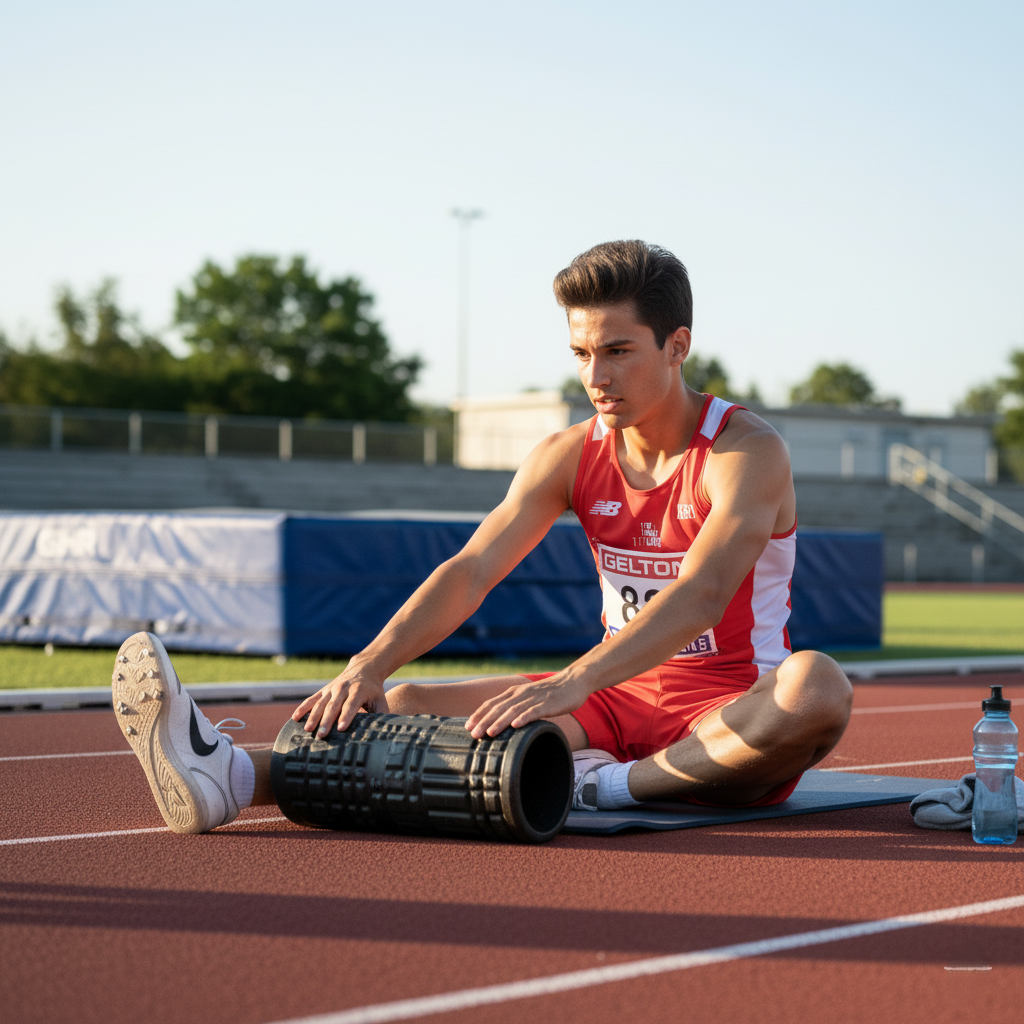High Jumper Training Load: Introduction
The high jump demands a unique combination of explosive power, technique, and mental focus. Behind every successful clearance lies countless hours of meticulous training—but not just any training. The difference between champion high jumpers and those who plateau often comes down to one critical factor: how effectively they monitor and manage their training loads.
For high jump athletes striving to reach new heights (literally), finding the perfect balance between pushing limits and avoiding overtraining represents one of the sport’s greatest challenges. Too much intensity can lead to burnout and injuries, while insufficient training stimulus prevents progress. This delicate equilibrium becomes even more complex when considering the multifaceted nature of high jump training, which encompasses everything from plyometrics and strength conditioning to technical drills and actual jumps.
In this comprehensive guide, we’ll explore expert-backed strategies for optimizing high jumper training load. Drawing from sports science research and elite coaching methodologies, we’ll provide actionable insights for athletes and coaches seeking to maximize strength gains and technical proficiency while minimizing injury risks. Whether you’re competing at an elite level or coaching developing jumpers, these approaches to training load management can help transform performance outcomes and extend athletic careers.
High Jumper Training Load: Implementing Periodization in Training
Periodization stands as the cornerstone of any effective high jump training program. This systematic approach to training organization divides the year into distinct phases, each with specific objectives and appropriate training intensities. For high jumpers, whose sport demands both technical proficiency and explosive power, periodized training ensures continuous progress while reducing overtraining risks.
Macrocycles typically span an entire season or year, outlining the broad trajectory from off-season development to competition peaks. Within each macrocycle, mesocycles (usually 3-6 weeks) focus on specific physical attributes—perhaps emphasizing strength development in one block before transitioning to explosive power or technical refinement in subsequent blocks. At the most granular level, microcycles (typically weekly plans) dictate day-to-day training variations, ensuring appropriate stimulus and recovery.
Successful high jump periodization must account for the unique demands of the event. For instance, during general preparation phases, training volume remains relatively high while intensity stays moderate, emphasizing foundational strength and conditioning. As competition approaches, training volume decreases while intensity increases, with greater focus on jump-specific exercises and technique refinement. Olympic high jump coach Stefan Holm notes, ‘The periodization model provides structure, but great coaches know when to adjust the plan based on athlete response rather than rigidly following predetermined volumes.’
Importantly, each phase must include appropriate load progression. Research suggests that increases of 5-10% in training load per week strike the optimal balance between adaptation and injury prevention for most athletes. Monitoring metrics like jump counts, weightlifting totals, and session RPE (Rating of Perceived Exertion) provides objective data to ensure these progressions remain appropriate for individual athletes.
By implementing strategic periodization, high jumpers can systematically build strength, power, and technique while minimizing overtraining risks—creating the perfect foundation for peak performances at target competitions.
- Divide the training year into macro, meso, and microcycles.
- Adjust training intensity and volume according to each phase.

High Jumper Training Load: Utilizing Technology for Training Monitoring
Modern technology has revolutionized how high jumpers and their coaches monitor training loads. Beyond simple jump counts or weight room numbers, today’s athletes have access to sophisticated tools that provide unprecedented insights into training effects and physiological responses.
Wearable devices represent the front line in training load management. Force plates and pressure sensors can measure ground reaction forces during takeoffs, revealing subtle efficiency changes that might escape visual observation. Velocity-based training devices attached to barbells provide immediate feedback on power output during strength exercises, allowing coaches to prescribe precise intensity ranges rather than arbitrary percentages of one-rep maximums. Even smartphone applications with built-in accelerometers can track jump heights and contact times during plyometric sessions.
Biometric tracking adds another dimension to training load monitoring. Heart rate variability (HRV) measurements offer insights into autonomic nervous system recovery, with decreasing variability often signaling accumulated fatigue before subjective symptoms appear. Sleep quality monitors help athletes ensure they’re getting adequate recovery time—a crucial but often overlooked aspect of training load management.
Data aggregation platforms now allow coaches to integrate multiple metrics into comprehensive dashboards. These systems can identify correlations between training variables and performance outcomes, helping coaches refine their loading strategies for individual athletes. As high jump coach Erin Carson explains, ‘The technology doesn’t replace coaching intuition—it enhances it by providing objective data to support or challenge our observations.’
Most importantly, these technological tools enable personalized approaches to training load management. High jumpers with different training histories, physical attributes, and recovery capabilities can receive individualized prescriptions based on their unique response patterns. This personalization represents perhaps the greatest advantage of technology-assisted monitoring, acknowledging that optimal training loads vary significantly between athletes even at similar performance levels.
- Use wearable devices to track biometrics and training metrics.
- Analyze data to make informed adjustments to training plans.

High Jumper Training Load: Incorporating Recovery Protocols
For high jumpers, recovery isn’t merely the absence of training—it’s an active process that directly influences adaptation and performance capacity. Implementing structured recovery protocols proves just as important as the training stimulus itself when optimizing training loads.
Strategic rest days represent the foundation of effective recovery programming. Research indicates that high jumpers benefit from at least one complete rest day per week, allowing physiological systems to reset and adaptation processes to complete. Additionally, scheduling lower-intensity technical sessions between high-intensity days creates a natural undulation in training stress that promotes sustainable progression.
Active recovery techniques have gained prominence in elite high jump programs. These moderate-intensity activities—like light jogging, swimming, or cycling—increase blood flow to fatigued muscles without creating additional fatigue. Studies suggest that 20-30 minutes of activity at approximately 60% of maximum heart rate optimally balances recovery benefits without compromising adaptation.
Physical therapy modalities offer another recovery dimension. Foam rolling and self-myofascial release techniques help address tissue restrictions that might compromise jumping mechanics. Strategic compression garment use has shown benefits for reducing post-training inflammation, particularly after high-volume plyometric sessions that characterize high jump training.
Nutritional timing plays a crucial role in recovery protocols. High jumpers should consume approximately 20-25 grams of protein within 30 minutes after training to maximize muscle protein synthesis. Additionally, replacing glycogen stores with 1-1.2g of carbohydrates per kilogram of body weight helps prepare for subsequent training sessions.
Sleep quality and quantity remain perhaps the most underappreciated aspects of recovery. Research consistently demonstrates that sleep deprivation significantly impairs power output—a critical component for high jumpers. Elite programs now recommend 8-10 hours of sleep daily for power athletes, with some incorporating scheduled napping protocols between split training sessions.
By intentionally incorporating these recovery elements into training plans, high jumpers can sustain higher quality training loads while reducing injury risks—ultimately translating to more consistent performance improvements.
- Schedule regular rest days and active recovery sessions.
- Implement techniques such as stretching, foam rolling, and massage.

High Jumper Training Load: Conclusion
Optimizing training load for high jumpers represents both science and art—requiring objective monitoring systems alongside coaching intuition and individualized approaches. The strategies outlined in this article provide a framework for maximizing strength gains and technical development while minimizing injury risks.
Periodization provides the structural foundation, ensuring systematic progression throughout training cycles. Technological monitoring tools offer unprecedented insights into how individual athletes respond to training stimuli. Strategic recovery protocols transform passive downtime into active regeneration opportunities. Performance metrics guide real-time adjustments to planned programs. Finally, thoughtful integration of strength and technical components creates synergistic rather than competing adaptations.
The common thread throughout these strategies is individualization. While general principles apply broadly, the optimal training load for each high jumper depends on their unique physical attributes, training history, recovery capacity, and technical efficiency. Coaches and athletes who embrace this individualized approach—systematically monitoring responses and adjusting accordingly—consistently produce superior results compared to those following rigid, predetermined programs.
Implementing these strategies requires commitment and patience. Collecting baseline data, establishing monitoring systems, and identifying individual response patterns takes time. However, this investment pays tremendous dividends through enhanced performance consistency, reduced injury rates, and extended competitive careers.
As sports science continues advancing, training load management approaches will undoubtedly evolve. However, the fundamental principle remains unchanged: optimal high jump performance results from applying appropriate training stimuli followed by adequate recovery. By thoughtfully monitoring and managing this process, coaches and athletes can ensure that every training session contributes maximally toward reaching new heights in competitive performance.
Coach Otto is a certified track and field coach with over 15 years of experience working with high jumpers at high school, collegiate, and elite levels.

